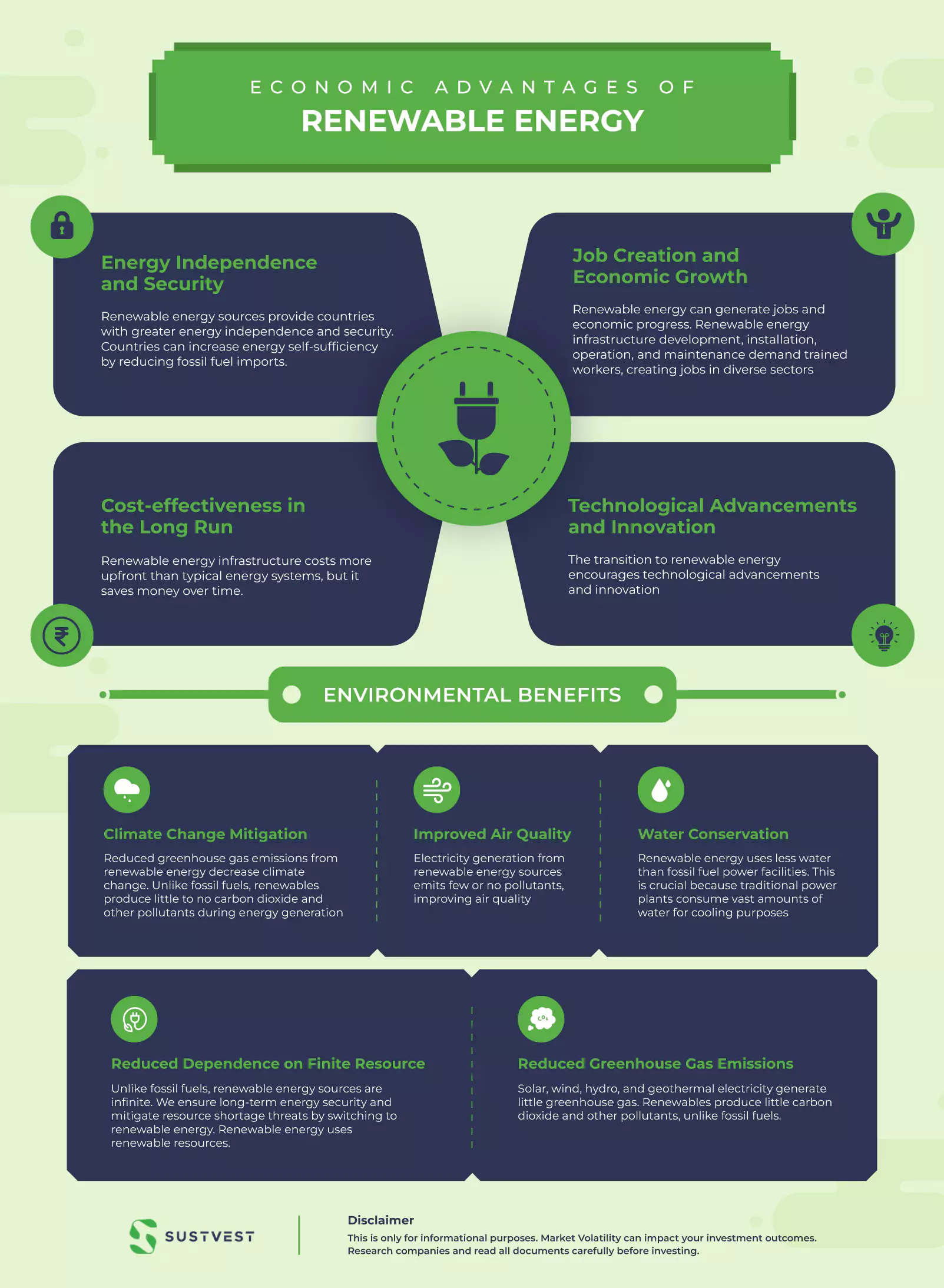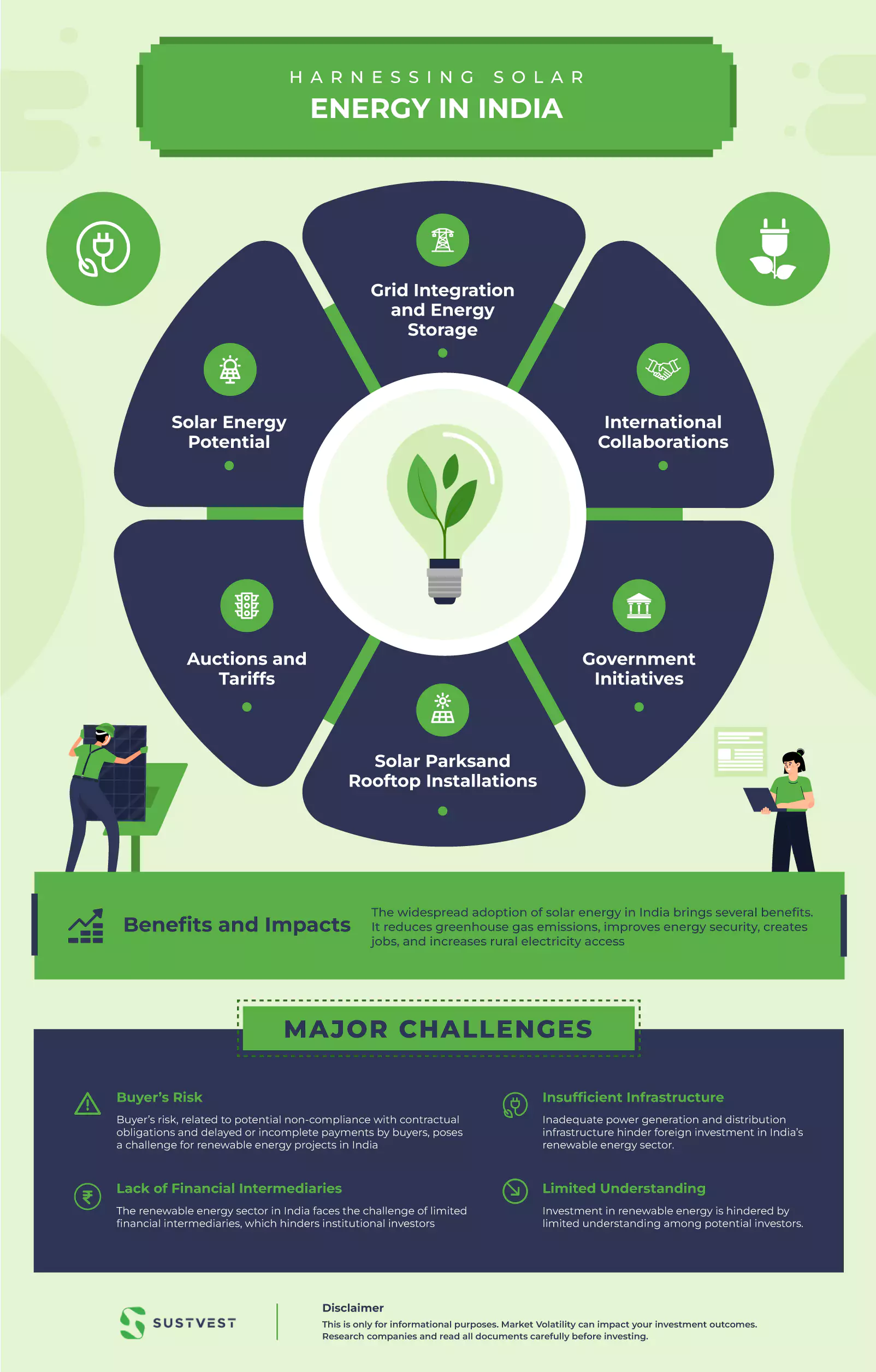Picture yourself in an electrifying Indian city, alive with bustling energy. But pause, what if the hum of this city was powered entirely by the bounty of nature?
A world where every light is sparked by wind, sun, or water – renewable sources of energy. It may seem fantastical, but it is indeed the vision of our future.
What’s the importance of renewable energy, you ask? It’s about more than just power. It’s about curbing our carbon footprint, fostering energy independence, spawning green jobs, and nurturing a cleaner, healthier environment. The importance of renewable energy resources is vast, varied, and vital to our sustainable progression.
Come join us as we navigate through this transition, unwrapping the significance of renewables and envisaging a future where our energy reflects the very essence of sustainability. Together, let’s turn the tides towards a greener tomorrow.

Environmental Benefits of Renewable Energy
Renewable energy provides numerous environmental advantages over fossil fuels. Let’s find out the Importance of renewable energy resources:
1. Reduced Greenhouse Gas Emissions
Solar, wind, hydro, and geothermal electricity generate little greenhouse gas. Renewables produce little carbon dioxide and other pollutants, unlike fossil fuels.
This greenhouse gas emission reduction helps minimise global warming and its environmental impacts. By shifting to renewable energy, we can lower our carbon footprint and help the Earth.
2. Climate Change Mitigation
Reduced greenhouse gas emissions from renewable energy decrease climate change. Unlike fossil fuels, renewables produce little to no carbon dioxide and other pollutants during energy generation.
By curbing these emissions, renewable energy helps stabilise and lower greenhouse gas concentrations in the atmosphere. This reduces global warming and climate threats.
3. Improved Air Quality
Electricity generation from renewable energy sources emits few or no pollutants, improving air quality. Renewable energy technologies produce clean energy with low air pollution emissions. Reducing pollution reduces respiratory issues and other air quality-related disorders, protecting human health.
Additionally, cleaner air resulting from renewable energy adoption has broader environmental benefits, including the preservation of ecosystems and the mitigation of climate change.
4. Water Conservation
Renewable energy uses less water than fossil fuel power facilities. This is crucial because traditional power plants consume vast amounts of water for cooling purposes. In drought-prone areas, renewable energy helps conserve water.
This water conservation aspect of renewable energy helps to address the growing global water crisis and ensures that water supplies are available for essential needs such as agriculture, drinking water, and ecosystem preservation.
5. Reduced Dependence on Finite Resource
Unlike fossil fuels, renewable energy sources are infinite. We ensure long-term energy security and mitigate resource shortage threats by switching to renewable energy. Renewable energy uses renewable resources.
These resources include sunlight, wind, and water. This transition encourages sustainable development by using renewable resources that will last for generations without harming the environment.
Examining these trends is crucial for understanding the importance of renewable energy resources, which aligns with the key insights of What Is the Future of Renewable Energy? Exploring Trends, Growth, and India’s Impressive Strides.
Economic Advantages of Renewable Energy

Renewable energy boosts economic growth and sustainability. Renewable energy has several economic advantages:
1. Energy Independence and Security
Renewable energy sources provide countries with greater energy independence and security. Countries can increase energy self-sufficiency by reducing fossil fuel imports.
They become less sensitive to global fuel price changes and energy-related geopolitics. Sunlight, wind, and biomass are abundant home energy sources that countries can use.
This promotes energy security by diversifying the energy mix and reducing reliance on finite and often geopolitically sensitive fossil fuel reserves.
Energy independence also reduces exposure to supply disruptions and enhances national resilience in the face of global energy uncertainties.
2. Cost-effectiveness in the Long Run
Renewable energy infrastructure costs more upfront than typical energy systems, but it saves money over time.
After installation, renewable energy systems cost less to operate than fossil fuel power plants. Solar and wind power employ abundant natural resources and have cheap fuel costs.
These technologies become cost-competitive with traditional energy as they mature and scale. Renewable energy reduces energy costs and boosts financial sustainability for individuals, businesses, and governments.
This creates a lucrative investment opportunity, a topic thoroughly explored in How to Make A Solar Investment In India?
3. Job Creation and Economic Growth
Renewable energy can generate jobs and economic progress. Renewable energy infrastructure development, installation, operation, and maintenance demand trained workers, creating jobs in diverse sectors.
As the renewable energy industry expands, it stimulates economic activity and attracts investments. Renewable energy expansion can also benefit allied industries, including equipment manufacturing, infrastructure construction, R&D, and support services.
These benefits boost economic growth, tax revenues, and local and regional development.
4. Technological Advancements and Innovation
The transition to renewable energy encourages technological advancements and innovation.
As renewable energy demand rises, R&D efforts focus on efficiency, storage, and grid integration. This breakthrough spurs the creation of more efficient solar panels, wind turbines, and energy storage options.
These advancements not only benefit the renewable energy sector but also have spillover effects in other industries, fostering overall technological progress.
Harnessing Solar Energy in India

India has advanced in solar energy use. Here are some crucial considerations about solar energy in India:
- Solar Energy Potential: India is ideal for solar power generation due to its year-round sunshine. With large solar installation areas, the country boasts one of the world’s biggest solar energy potentials.
- Government Initiatives: The Indian government has taken several initiatives to promote solar energy. Like The Jawaharlal Nehru National Solar Mission, which was founded in 2010. It intends to promote solar energy and reach 280 GW of solar power capacity by 2030. Financial incentives and subsidies are offered to attract solar investments.
- Solar Parks and Rooftop Installations: India has established solar parks in different states to facilitate large-scale solar power projects. These parks provide the necessary infrastructure, land, and transmission facilities to attract developers. Additionally, rooftop solar installations have gained momentum, particularly in commercial and industrial sectors, with policies encouraging solar panel installations on rooftops.
- Auctions and Tariffs: The solar energy sector in India operates through competitive bidding and auctions. The government conducts auctions to award solar projects to developers, ensuring transparency and encouraging cost-effective project development. Falling solar tariffs have been witnessed in recent years, making solar energy increasingly competitive with conventional sources of power.
- Grid Integration and Energy Storage: The integration of solar power into the electricity grid is a key focus in India. Efforts are being made to strengthen the grid infrastructure to accommodate increased solar power generation. Additionally, energy storage is being investigated to solve intermittency and ensure a reliable power supply.
- International Collaborations: India has collaborated with international organisations and countries to advance solar energy technologies. For instance, the International Solar Alliance (ISA) was launched by India and France to promote solar energy deployment and facilitate cooperation among solar-rich countries.
- Benefits and Impacts: The widespread adoption of solar energy in India brings several benefits. It reduces greenhouse gas emissions, improves energy security, creates jobs, and increases rural electricity access. Solar energy deployment supports climate change mitigation and the Paris Agreement.
Overall, India’s solar energy business is rising fast. India is now a global leader in solar energy deployment due to the government’s backing, regulations, and investments.
This rapid growth represents an exciting investment opportunity, a theme central to Investing in Renewable Energy- Best Investment Opportunity in India.
Major Challenges In the Renewable Energy Sector
India’s renewable energy sector faces challenges, including off-taker risk, infrastructure gaps, limited financial intermediaries, and investor understanding, hindering its progress. Let’s find out the challenges and ways to mitigate them
Buyer’s Risk
Buyer’s risk, related to potential non-compliance with contractual obligations and delayed or incomplete payments by buyers, poses a challenge for renewable energy projects in India.
Indian distributors’ weak financial condition has resulted in significant outstanding debt, reaching approximately $64 billion in 2015.
To mitigate this risk, the government launched the Ujwal DISCOM Assurance Yojana, which aims to improve the financial performance of distributors by converting 75% of their debt into government-guaranteed bonds.
This initiative seeks to enhance operational efficiency and reduce overall risk in the renewable energy sector.
Insufficient Infrastructure
Inadequate power generation and distribution infrastructure hinder foreign investment in India’s renewable energy sector.
The absence of necessary infrastructure, such as powerline evacuation systems, results in inefficiencies and project construction and commissioning delays.
Obtaining permits for infrastructure development also involves time-consuming processes. These challenges hinder revenue generation and profit realisation, discouraging potential investors from entering the market.
Lack of Financial Intermediaries
The renewable energy sector in India faces the challenge of limited financial intermediaries, which hinders institutional investors. These intermediaries play a crucial role in providing essential information and expertise about investment opportunities, risk assessment, and financial structuring.
The absence of such intermediaries makes it difficult for investors to navigate the renewable energy market effectively and evaluate potential projects.
To mitigate this challenge, efforts should focus on strengthening the ecosystem of financial intermediaries through capacity building, promoting specialised renewable energy investment funds, and encouraging partnerships between financial institutions & renewable energy developers to enhance investor understanding and support the flow of capital into the sector.
Limited Understanding
Investment in renewable energy is hindered by limited understanding among potential investors.
The sector is viewed as non-traditional, leading to caution and hesitancy. Domestic institutional investors, who prioritise low-risk securities, tend to favour liquid assets with high credit ratings, which are not commonly associated with renewable energy projects.
Addressing this knowledge gap and promoting awareness about renewable energy’s financial viability and long-term benefits can help attract more investment in the sector.
FAQs
Are renewable energy technologies expensive to implement?
Initially, the setup costs for renewable energy technologies may be higher, but over time, they can prove to be more cost-effective due to reduced operational expenses and long-term savings on fuel costs.
Are all regions suitable for harnessing renewable energy?
Different regions have varying renewable energy potential, depending on factors like sunlight, wind speed, water resources, and geothermal activity. However, many areas can still benefit from a combination of renewable sources to meet their energy demands.
How does renewable energy contribute to job creation?
The transition to renewable energy creates job opportunities in various sectors such as manufacturing, installation, maintenance, research, and development, fostering economic growth and supporting a sustainable workforce.
What challenges exist in integrating renewable energy into existing power grids?
Integrating renewable energy into existing grids requires addressing issues like intermittency, grid stability, storage capacity, and infrastructure upgrades. However, advancements in technology and smart grid solutions are facilitating smoother integration and efficient utilization of renewable power.
Conclusion
India’s renewable energy transition has huge potential for sustainability and prosperity. Solar, wind, biomass, and other renewables can fight climate change, cut carbon emissions, and maintain our natural resources.
Economic gains include energy independence, cost-effectiveness, and job development. Individuals, businesses, and policymakers must support sustainable investments to realise this ambition.
Let’s admire the importance of renewable energy resources and adapt it for a greener future. Join the sustainability revolution with Sustvest, and let’s shape a brighter future for India and the planet.

Founder of Sustvest
Hardik completed his B.Tech from BITS Pilani. Keeping the current global scenario, the growth of renewable energy in mind, and people looking for investment opportunities in mind he founded SustVest ( formerly, Solar Grid X ) in 2018. This venture led him to achieve the ‘Emerging Fintech Talent of the Year in MENA region ‘ in October 2019.




